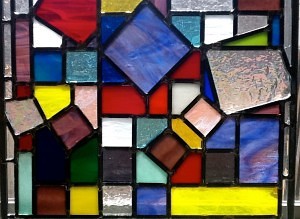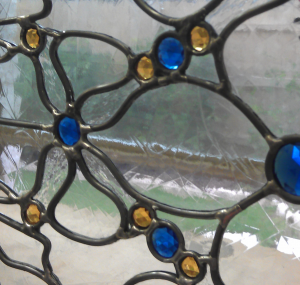What is Stained Glass?
You’ve seen a lot of stained glass – in everything from glass bottles to church windows. Stained glass has been produced and enjoyed for millennia because of its beauty, manufacturability and durability. But what is stained glass made from? Below is a short discussion on stained glass and the projects we love to make with it.
The Color of Glass
We are often asked how our glass gets its color. The glass we use is made in specific colors. It is “stained” through the manufacturing process, not by coloring it afterwards. Clear glass is made from silica sand and other ingredients to give it the proper clarity, melting temperature and strength.
Glass is colored by adding metal oxides or metal powders to molten glass. Depending on the metal, the glass takes on a particular color. You may have seen “cobalt blue” glass –yes, that color comes from adding cobalt. Copper oxides also make glass blue to bluish green. Sulfur and cadmium make yellow. Iron oxides produce greens and browns. Tin produces white. Chrome produces emerald greens. In early glass production, the rarest of colors was red. This is because red required the most costly of additives – gold. Today, chemists have found other ingredients that produce red, but you will not see much red glass in truely antique stained glass. (Learn more: See the Geology.com article “Elements of Color” for more on metal oxide coloring of glass. See the videos from Bullseye Glass for more on glass manufacturing.)
Even more costly are iridized and dichroic glasses. Iridized glass is made by adding a thin coating of metal oxide to the glass sheet. “Irid” glasses have a rainbow effect. Dichroic, or “dichro”, glass is made by adding multiple ultra-thin layers of these oxides to the glass. This makes dichro glass change color depending on the angle of viewing. With this property, and some texture to change that view angle, some amazing color effects can be created with dichro glass. (Learn more: See the Wikipedia article “Dichroic Glass”.) We use many colors of glass in our studio, including reds, irid and dichro. (Browse our portfolio to see how we use colored glass.)
Leaded Stained Glass Windows
At Renegade, we use stained glass material in all of our art, but when we refer to a stained glass project, it is usually a window for use in a home, business or church. At its most basic level, a stained glass project consists of pieces of glass whose edges are joined together in some manner.
There are two common materials used to join glass –copper foil and lead. With each, the glass edges are held in a channel that conforms to the shape of the piece. Copper foil is commonly used by hobbyists due to its ease of assembly. Lead is more costly and difficult to use, but requires far less solder and produces a very uniform, predictable result. At Renegade, we use lead in our stained glass projects, but we often repair copper foil items for customers.
A stained glass project is created in several steps. First, a pattern is designed that contains information on the precise shape and color of each piece. Today we often use computer-aided design to create the patterns, but many stained glass artists still use only pencil and paper. We will then typically print this pattern at full size to use in building the window. We can also use prints of the design to help visualize and adjust the final project. (See our Services page for info on printing patterns for your own designs.) The glass pieces are individually cut to fit the pattern. A collection of tools are used to do this, from cutters and pliers to diamond grit grinders.
Each piece is fit into an “H” channel shaped strip of lead, called came. The came is cut and bent to fit tightly around each piece. The ends of the came are then soldered together. Finishing the piece may include cementing the glass to the came – to produce a more sturdy window – and possibly treating the came and solder with chemicals to tint them.
Once the window is completed, it must be cleaned. Due to the remnants of the soldering and cementing processes, this can take almost as much time as building the window.
If the project is to be an exterior window or door, we may also “triple glaze” the piece.  This involves sandwiching it between two pieces of clear glass, with sealed spacer around the edge. The result becomes an insulated glass unit (IGU). Protected this way the window is easy to clean, extremely durable and a very good insulator for exterior windows and doors. The window will then be hung or installed, and hopefully enjoyed for many years to come. (Learn more: See the Wikipedia article “Stained Glass”.)
This involves sandwiching it between two pieces of clear glass, with sealed spacer around the edge. The result becomes an insulated glass unit (IGU). Protected this way the window is easy to clean, extremely durable and a very good insulator for exterior windows and doors. The window will then be hung or installed, and hopefully enjoyed for many years to come. (Learn more: See the Wikipedia article “Stained Glass”.)
Please contact us if you have questions about stained glass, or would like Renegade to work with you on a stained glass project.
